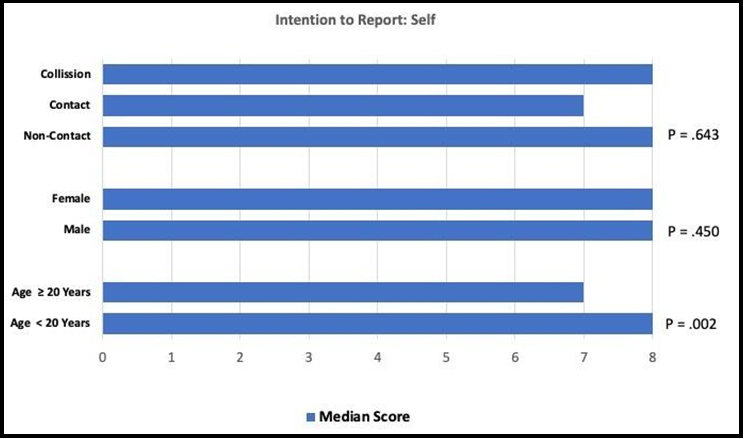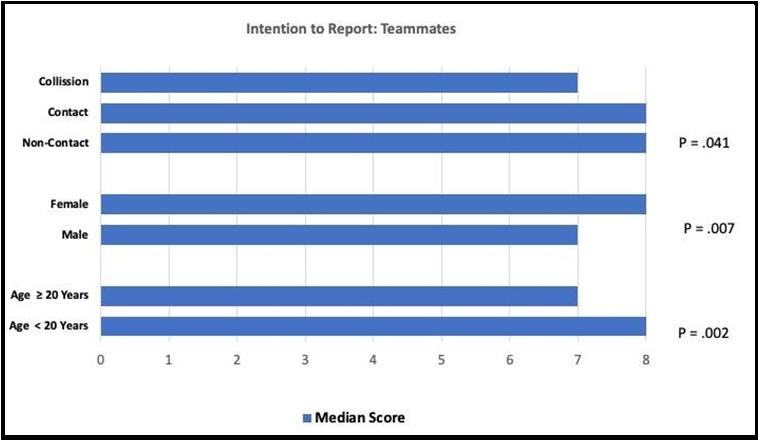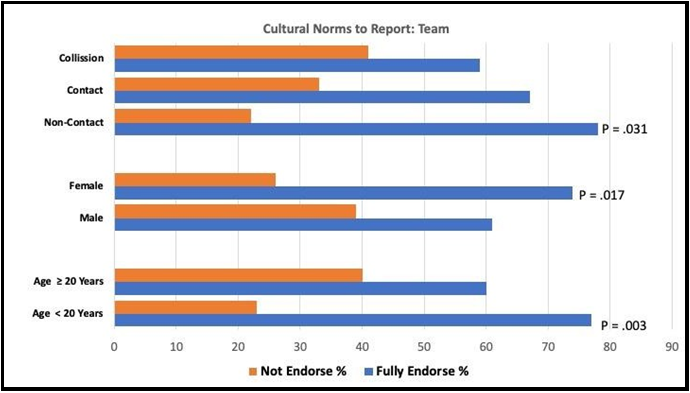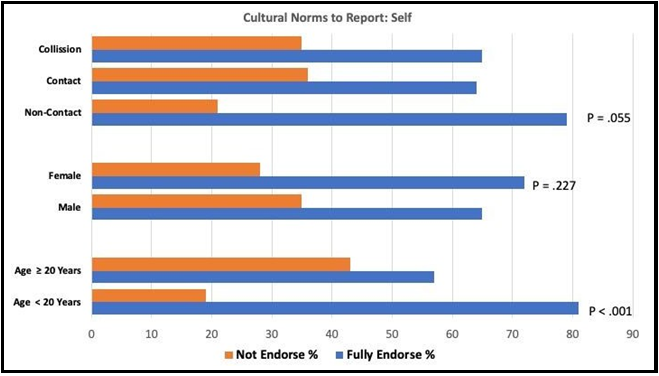Joseph W. Penna, OMS-II1*, Humza Ali, OMS-II1, Danielle E. Jewell1, Katie Stephenson, Ph.D.1, Michael Goddu, B.S.1, Gregory F. Marchetti, PT, Ph.D., CPE2, Lily Herrmann, BA3, Paul D. Berkner, DO1
1University of New England, ME, USA
2Duquesne University, PA, USA
3Colby College, ME, USA.
*Corresponding Author: Joseph W. Penna, OMS-II, University of New England, ME, USA.
Abstract
Background: Underreporting concussions is a persistent problem among student-athletes and can potentially lead to adverse health outcomes. The reasons for underreporting are multifactorial, but one factor is Pluralistic Ignorance (PI). This research aimed to evaluate PI's impact on the decisions of concussion reporting amongst NCAA Division III athletes. We propose that the effects of PI will vary due to gender, age, and type of sport when individuals respond to surveys taken in a group setting.
Methods: A Qualtrics® survey that contained video vignettes depicting concussions and other injuries was administered to 278 NCAA Division III athletes in a group team setting.
Results: Eighteen- to 19-year-olds indicated a greater intention to self-report a concussion than 20–26-year-olds. Scores on an individual's perception of their teammate's purpose in reporting an injury were more excellent in underclassmen and female athletes. Younger, female, and non-contact athletes endorsed a culture of self-reporting and teammate-reporting of concussions.
Conclusion: The results of younger, non-contact, and female student-athletes showed greater intentions of reporting concussions. The methods used in this study could provide a framework for educating teams in a group setting to mitigate the potentially harmful behavior of not reporting concussions.
Keywords: Concussion, Underreporting, Collegiate, Pluralistic Ignorance, Sports
Introduction
An estimated 285,000 collegiate athletes compete in an organized sport every year (National Collegiate Athletic Association, n.d.); however, this most likely underrepresents the actual number of concussions due to underreporting by athletes [6]. The underreporting of concussions is a phenomenon that has been well-documented in athletes [12]. It is estimated that underreporting concussions could be as high as one-third of all athletes that received a blow to the head, followed by signs and symptoms consistent with a trauma [13]. The underreporting of concussion is an adverse health behavior that may have significant consequences for the individual, explicitly playing while concussed, which has been shown to lead to protracted recovery [8].
Previous research has attempted to identify the factors which lead to underreporting of concussions to improve athletes reporting injuries; however, athletes' reasons for underreporting traumas are multifaceted. Kerr and colleagues (2016) conducted a study using former collegiate athletes to recall their self-identified sports-related concussions. They concluded that male athletes were more likely to avoid reporting their concussions than female and non-contact athletes. This study was limited due to the inability to control for current team culture surrounding trauma and the age of athletes.
Several psychosocial explanations have been proposed to understand better this adverse health behavior, such as the Theory of Planned Behavior (TPB) [1]. The TPB submitted by Ajzen (2011) explains that knowledge may be optional in decision-making. Instead, subjectively held information (i.e., beliefs) links a behavior of interest to positive or negative outcomes, to the normative expectations of influential referent individuals or groups, and to control factors that can facilitate or inhibit the performance of the behavior [1]. Using the TPB theory, Kroshus and colleagues (2014) examined TPB in concussions and found underreporting was caused by the perceived adverse outcomes, such as short-term athletic performance, being held out of participation, perception of hurting their team, and not being allowed to play when fellow teammates think they are ready [11]. Although TPB helped explain underreporting, it did not fully explain the phenomenon.
In addition to TPB, Pluralistic Ignorance (PI) is another psychosocial theory in which individuals mistakenly believe others' cognitions and behaviors are different from their own and therefore use that perception to determine their behavior [16]. PI has been demonstrated in other collegiate social interactions, such as alcohol use. According to Prentice & Miller in 1993, students consume more alcohol because they perceive that their peers are drinking more than they are [14]. Using PI and relating it to sports concussions, this psychosocial phenomenon could similarly impact student-athletes. Individuals may choose not to report concussions because they mistakenly believe their peers would do the same.
PI has been demonstrated in a study involving air force cadets in which females and upper-level students were more likely to believe they would report a concussion compared to their fellow peers [3].
This dissonance illustrates PI; the cadets held an improper belief that their peers were less likely to report a concussion than themselves. Thus, PI may be one factor associated with underreporting amongst collegiate and high school athletes.
In this current study, we examined the prevalence of PI among Division III college athletes. Additionally, the effect of gender, age, and sport type were explored for associations with reporting norms. We hypothesize that female, younger athletes, and contact/collision sport athletes will vary in responses on a survey designed to evaluate underreporting criteria.
Methods
Survey Creation
A novel survey was created by drawing questions from Rosenbaum and Arnett (2010), and Kroshus and colleagues (2014) published works to explore PI of concussion reporting. This survey was conducted in person and a team setting, with individuals responding to questions on an electronic device relating to video vignettes of both concussion and non-concussive injury events.
The final survey was created using Qualtrics® and contained 81 questions that focused on concussion knowledge, impulsivity, the intention of self and teammate to report concussions, and cultural reporting norms. The university's institutional review board approved the study protocol.
Measures
The survey was structured, so that the participants answered the same questions in three scenarios: self, teammate, and team. These questions allowed a comparison of self-versus perceived teammate concussion reporting. The questions were formatted so that the answer choices were either true or false or based on a 5-point Likert scale (strongly agree, somewhat agree, neither agree nor disagree, somewhat disagree, and strongly disagree).
The survey questions were divided into the following six domains: knowledge (13 items), impulsivity (23 items), self-intention to report (8 items), teammate intention to write (9 articles), cultural reporting norms for self (4 items), and cultural reporting norms for teammates (3 items). The impulsivity questions were derived from the Dickman functional and dysfunctional impulsivity scale [7]. The concussion knowledge questions, intention to self-report, and cultural reporting norms were derived from Kroshus and colleagues (2014).
Scores on the domains for analysis were based on the endorsement of correct answers (knowledge items) or agreement on the Likert scale items, dichotomized as any level of understanding versus neutral to disagreement. Domain scores were calculated based on the number of endorsed items ranging from "impulsivity" (0-23) to "cultural reporting norms for teammates" (0-3).
Survey participants and procedure
The survey was administered to 295 NCAA Division III athletes (18- 26 years). Thirteen sports were represented: men's baseball, men's basketball, men's ice hockey, men's and women's lacrosse, women's field hockey, women's volleyball, men's football, women's soccer, women's softball, women's squash, men's and women's Nordic skiing, men's and women's rugby, and men's and women's ultimate frisbee. This survey was done in a team setting using mobile devices to respond to the study. This survey included video vignettes depicting concussions and other injuries. Individuals with missing data were excluded from the study.
Statistical Analysis
Descriptive statistics for survey respondents were presented as means, standard deviations, and frequencies/percentages as appropriate.
For analysis of comparisons with age (dichotomized at < 20 or > 20 years), gender, and contact sports category, responses were dichotomized based on question type as True/False or indicating any level of agreement on the Likert scale items (agree somewhat or strongly). An a priori power analysis was conducted for the difference between categorical responses in gender groups. Based on samples of 130 male and 148 female participants, it was estimated that a 27 % dichotomous response difference could be identified at a minimum of 80 % power.
Domain scores were determined as the number of correct or agreement responses within each category. Age, gender, and contact sport group differences in domain scores/categories were compared with Mann-Whitney U/Kruskal-Wallis tests (ordinal scores) and contingency table with chi-square analysis (categorical) depending on the number of items in each domain. A type I error rate < .05 was used for statistical comparisons.
Results
Survey responses were analyzed from 277 subjects, 130 (46.9 %) males and 147 (53.1 %) females. The mean age of the respondents was 19.7 years (SD 1.4, range 18-26). Contact sport participation (n = 108, 39 %) was the most frequently reported activity compared with non-contact (n = 89, 32.1 %) and collision (n = 80, 28.9 %). Total scores on the knowledge domain questions were significantly more excellent for females (Z = 2.40, P = .018) and for contact sports participants (H = 9.44, df = 2, P = .009) compared with non-contact/collision groups. Males scored higher on impulsivity domain questions (Z = 4.57, P < .001). Scores on impulsivity were lowest in the contact sports participants (H = 7.72, df = 2, P = .021) compared with non-contact/collision groups. Measures of knowledge and impulsivity did not differ significantly between age groups.
Intention to report: Self
There was no significant difference due to gender (Z = .755, P = .450) or contact sports participation (H = 0.882, df = 2, P = .643) on scores indicating the intention to self-report an injury. Subjects 19 years and younger showed a greater purpose to self-report an injury (mean score 6.7) than subjects 20 years and older (mean score 5.8, Z = 3.09, P = .002).
Intention to report: Team
Scores on an individual's perception of their teammate's intention to report an injury were significantly greater in subjects younger than 20 years (Z = 3.161, P = .002) and among female issues (Z = 2.70, P = .007). There was a significant effect on the intention to report a teammate's injury due to the contact nature of the sport, with collision sport participants scoring lower on the perception of writing intent than non-contact or contact (H = 6.38, P = .041).
Cultural Reporting Norms: Self
Full endorsement of a culture of self-reporting an injury was observed in 80.4 % of subjects 19 years and younger compared with 58.3 % of those 20 years and older (chi-square = 15.80, df = 1, P < .001). There was no significant difference by gender or contact sport participation in the observed endorsement of culture in favor of self-reporting an injury.
Cultural Reporting Norms: Team
Full endorsement of a culture of team reporting of an injury was reported by 76.7 % of subjects 19 years and younger compared with 59.7 % of those 20 years and older (chi-square = 9.130, df = 1, P = .003). Females (74.1 %) were more likely to fully endorse a team reporting culture than males (60.7 %, Chi-square = 5.66, df = 1, P = .017). A significant difference was observed between sports groups in a team culture of reporting (chi-square = 6.93, df = 2, P = .031). The full endorsement was highest in non-contact participants (77.5 %) compared with contact (66.7 %) and collision (59.3 %) sports groups.
Table 1: Characteristics of 277 student-athletes completing cultural norm survey regarding sport related concussion reporting.
|
Characteristic |
Sample value |
|
Age (years, mean ± SD, range) |
19.8 ± 1.4, 18-26 |
|
Age > 20 years, n (%) |
144 (52) |
|
Female Gender, n (%) |
147 (53.1) |
|
Sport contact category, n (%) Non-contact Contact Collision |
89 (32.1) 108 (39) 80 (28.9) |
Table 2: Concussion reporting domain scores for 277 student athletes.
|
Underreporting Doman |
Score results |
|
Knowledge (mean ± SD, range) |
10 ± 1.3, 5-13 |
|
Impulsivity (mean ± SD, range) |
9.8 ± 4.6, 0-23 |
|
Intention to report: self (mean ± SD, range) |
6.2 ± 2.4, 0-8 |
|
Intention to report teammate (mean ± SD, range) |
6.7 ± 2.5, 0-9 |
|
Culture supportive of reporting: self, n (%) 0 1 2 3 |
9 (3.2) 28 (10.1) 49 (17.7) 192 (69.0) |
|
Culture supportive of reporting: team, n (%) 0 1 2 3 |
17 (6.1) 25 (9.0) 47 (17.0) 189 (67.9) |
Table 1 and 2: Table 1 contains the demographics of the student-athletes. It includes data on gender, age, and sport-contact category. Table 2 contains reporting domain scores from the survey. Knowledge, impulsivity, intention to report self, and intention to report teammate were scored by the mean average of questions answered correctly. Culture supportive of reporting with self and team was broken down into categories of the number of questions answered correctly (0 corresponding to no questions answered correctly to 3 corresponding to all answered correctly).
Figure 1a and 1b. Intention to Report. Student-athletes were asked a set of eight questions asking their intent to report a concussion based on symptoms and their perceived intention of their teammate to report due to the same symptoms. Endorsement means the participant indicated agreement with any of the eight of the questions in the intention to report domains. Endorsement scores range from 0-8.
Figure 1a.
Figure 1b.
Figure 2a.
Figure 2b.
Figure 2a and 2b. Cultural Reporting Norms: Student-athletes were asked a set of questions on how comfortable they themselves were to report a concussion to their athletic trainer and coaches. They were also asked their perceptions on how comfortable they think their teammates were to report their own concussions. These questions assessed the perceived concussion reporting norms of the team.
Discussion
To the authors' knowledge, this is the first study to use a vignette methodology to assess pluralistic ignorance with concussion reporting in collegiate athletes. Although we did not find PI among contact/collision athletes, older athletes, and male athletes, findings from the current study revealed that females, underclassmen, and non- contact athletes were more likely to have the intention to report concussion symptoms and feel as though they are part of a team culture that endorses concussion reporting. Therefore, it is plausible to infer that the team culture created a perception that teammates would report concussions and have a pluralistic impact on individual reporting of concussions. In conclusion, PI may affect specific ages, gender, and sports groups, which can help trainers and coaches identify which groups they need to create a more encouraging environment to report concussions.
The current study's findings were congruent with the Kerr et. Al (2016) in that female athletes and non-collision sports were more likely to self-report concussions. Our study enhanced their results by extending possible causation to why underreporting may occur, more specifically, pluralistic ignorance. The current study was able to mimic team culture and pressures by using team settings with concussion vignettes and current NCAA Division III athletes. Additionally, using current athletes allowed the present study to distinguish between upper and underclassmen behaviors, which further accounts for a team culture dynamic in concussion reporting. Although the recent research had comparative findings to Kerr et al. (2016), there were incongruent findings with Bough et. Al (2021) with Air Force Cadets.
The research on Air Force cadets showed that females and older individuals were less likely to endorse reporting concussions because their teammates would not want them to write their traumas [3]. The study design could account for the conflicting findings. Specifically, the current study was administered in a team setting with videos of concussions and other sports injuries as opposed to individual surveys, it involved NCAA Division III athletes, and it did not include individuals with future military service obligations and opportunities (e.g., future pilots). Additionally, the survey was administered in a team setting, with athletes completing the questions individually. The student-athletes were allowed to talk freely amongst themselves during the survey. This creates a different environment than when student-athletes take it independently. Individuals may respond more realistically due to their ability to incorporate their peer's opinions into their decision-making. This environment is more predictive of team culture and possible PI effects on individual athlete decisions regarding concussion reporting.
Furthermore, the survey also had several questions, including videos of concussion injuries. This format aimed to make concussions more concrete, thus enhancing the perception of the severity of concussions. The study used these two environmental influences to intentionally portray what would happen in an actual game situation and how it would affect individual behavior. Furthermore, because of these differences, the current study is likely more effective in predicting concussion reporting outcomes in NCAA collegiate athletes. Consequently, there are limitations with the present study regarding subject inclusion criteria. The subjects were made up of only Division III athletes. Therefore, results may differ across divisions such as division I and II.
Conclusion
In conclusion, the current study has determined that PI can impact the decisions made by different ages, gender, and sports, most specifically underclassmen, female athletes, and non-collision sports. This, therefore, builds upon the results found by Kerr et al. (2016) and directly opposes the effects of Bough et al. (2021). These results are most likely due to the unique characteristics of the survey, including accessible communication with teammates while taking the study, using video vignettes to describe concussions, using different domains such as self-reporting and team reporting, and using current NCAA division III athletes. These results will allow future athletic trainers and coaches to directly identify which groups are more likely to report their concussions (i.e., Female and non-collision sports) and therefore focus on male and collision sports to help cultivate an environment that encourages concussion reporting, regardless of pluralistic ignorance or outside factors. This study can also be a foundation to extend the psychosocial theories such as PI and TPB to help explain why the adverse health behavior of concussion underreporting exists.
Acknowledgements
The University of New England College of Osteopathic Medicine, Colby College, and the Maine Concussion Management Initiative. This research was approved by the IRB at Colby College. Special thanks to Lillie Hermann for creating and conducting the survey.
References
- Ajzen I, Joyce N, Sheikh S, Cote NG (2011) Knowledge and the Prediction of Behavior: The Role of Information Accuracy in the Theory of Planned Behavior. Basic and Applied Social Psychology. 33(2): 101–117.
- Bakhos LL, Lockhart GR, Myers R, Linakis JG (2010) Emergency department visits for concussion in young child athletes. Pediatrics. 126(3): e550-556.
- Baugh CM, Foster CA, Johnson BR, D'Lauro C (2021) Pluralistic Ignorance as a Contributing Factor to Concussion Underreporting. Health Education & Behavior. 49(2): 340-346.
- Cantu RC, Mueller FO (2009) The prevention of catastrophic head and spine injuries in high school and college sports. British Journal of Sports Medicine. 43(13): 981–986.
- Casper ST (2020) Including Second Impact Syndrome in Sports- Related Concussions Evidence Review. JAMA Pediatrics. 174(8): 802.
- DePadilla L (2018) Self-Reported Concussions from Playing a Sport or Being Physically Active Among High School Students— United States, 2017. MMWR. Morbidity and Mortality Weekly Report. 67(24): 682–685.
- Dickman SJ (1990) Functional and dysfunctional impulsivity: Personality and cognitive correlates. Journal of Personality and Social Psychology. 58(1): 95–102.
- Elbin RJ, Sufrinko A, Schatz P, French J, Henry L, et al. (2016) Removal from play after concussion and recovery time. Pediatrics. 138(3): e20160910.
- Estimated probability of competing in college athletics. (n.d.). NCAA.Org. Retrieved March 11, 2022.
- Kerr ZY, Register-Mihalik JK, Kroshus E, Baugh CM, Marshall SW (2016) Motivations Associated With Nondisclosure of Self- Reported Concussions in Former Collegiate Athletes. The American Journal of Sports Medicine. 44(1): 220–225.
- Kroshus E, Baugh CM, Daneshvar DH, Viswanath K (2014) Understanding concussion reporting using a model based on the theory of planned behavior. The Journal of Adolescent Health. 54(3): 269-274.e2.
- McCrea M, Hammeke T, Olsen G, Leo P, Guskiewicz K (2004) Unreported concussion in high school football players: Implications for prevention. Clinical Journal of Sport Medicine. 14(1): 13–17.
- Meehan WP, Mannix RC, O’Brien MJ, Collins MW (2013) The prevalence of undiagnosed concussions in athletes. Clinical Journal of Sport Medicine: Official Journal of the Canadian Academy of Sport Medicine. 23(5): 339–342.
- Prentice DA, Miller DT (1993) Pluralistic ignorance and alcohol use on campus: Some consequences of misperceiving the social norm. Journal of Personality and Social Psychology. 64(2): 243– 256.
- Rosenbaum AM, Arnett PA (2010) The development of a survey to examine knowledge about and attitudes toward concussion in high-school students. Journal of Clinical and Experimental Neuropsychology. 32(1): 44–55.
- Sargent RH, Newman LS (2021) Pluralistic Ignorance Research in Psychology: A Scoping Review of Topic and Method Variation and Directions for Future Research. Review of General Psychology. 25(2): 163–184.
- Van Grootel S, Van Laar C, Meeussen L, Schmader T, Sczesny S (2018) Uncovering Pluralistic Ignorance to Change Men’s Communal Self-descriptions, Attitudes, and Behavioral Intentions. Frontiers in Psychology. 9: 1344.
- Veliz P, Eckner JT, Zdroik J, Schulenberg JE (2019) Lifetime Prevalence of Self-Reported Concussion Among Adolescents Involved in Competitive Sports: A National U.S. Study. The Journal of Adolescent Health. 64(2): 272–275.
- Yaramothu C, Goodman AM, Alvarez TL (2019) Epidemiology and Incidence of Pediatric Concussions in General Aspects of Life. Brain Sciences, 9(10): 257.







